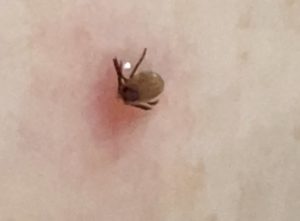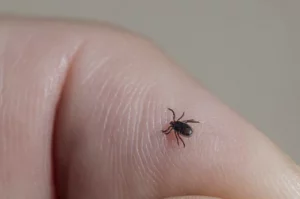Ticks in Scotland – what you need to know and why
I can’t say ‘Ticks in Scotland’ really ranks amongst the most interesting posts or articles I’ve ever written, however, it is quite important to be aware of if you’re in the Scottish Highlands, or even any other wooded or grassy areas in the UK.
So what are ticks? They come in many shapes and sizes and with interesting sounding names and some spread diseases more than others. There are few types of ticks in Scotland but the most common is the deer tick.
Unfortunately Scotland is one of the countries with ticks that can (not necessarily do) carry Lyme Disease which can have serious long-term effects if not caught in time.
Don’t panic! The number of ticks in Scotland carrying the disease is relatively low, the infection rate is lower still and there are several things you can do to help prevent bites and infection, so read on…
A tick is an eight-legged parasite that lives on hosts (although larvae have only six legs.) Deer ticks live not only on deer but on all sorts of animals such as sheep, dogs, cattle, mice, birds, reptiles and sometimes humans.
Disclosure: When you make a purchase through the links on this site, I may earn commission from partners. This helps me to build a site full of information and tips and to bring you more great posts!
Tick Bite Prevention
Let’s start with prevention. Whilst keeping your skin covered may help, it’s not enough on its own. This is a photo of a tick that managed to attach itself to my leg on Creag Mhor (the big hill at the back of Arisaig) a couple of months ago. I was wearing hiking socks and boots and long jeans at the time.

You can use an insect repellent that contains Deet to help. You can buy this in most pharmacies, big supermarkets or online. They also tend not to like the smell of citrus fruits so essential oils or anything else with citrus smells can help too. You’ll often find them together in a product.
If you’re spending a lot of time on the hills walking or wild camping, you might consider investing in Permethrin spray for clothes. Permethrin IS toxic so obviously has to be used correctly and to be kept away from animals and children so you might want to protect your clothes before leaving home to optimise safety. Otherwise, RepellShield Tick Repellant for Humans has some good reviews.
For dogs, a treatment like Frontline drops helps as well as tick collars and sprays but none of these are 100% effective so you should still check your dog. I’ve personally had to deal with a massive infestation of several dogs (don’t panic, not ticks in Scotland!) and found that their favourite places include those hidden spots which are also warm and moist – the armpits, groin area and the ears.
(As an Amazon Associate, I may earn from qualifying purchases. This does not affect prices.)
Check for ticks after possible exposure
As none of these methods of tick prevention are foolproof, we still need to check. I try to do regular checks after walks, etc because IF a tick is carrying Lyme Disease, it generally takes at least 36 hours of feeding from a host for it to be passed on.
The other important thing to know is that, unlike insect bites or stings, you won’t know about it because the little blighters are so sneaky that they have both anaesthetic and anti-inflammatory properties in their saliva!

The ticks that I’ve had in Scotland have been tiny and in the spring, and even early summer, they might still be larva or nymphs so even smaller. The photo above was taken with the magnifier in my iPhone.
I didn’t identify any of them as ticks at first sight. I thought it was a chocolate crumb or a tiny spot or scab. So it’s best to take a closer look at anything that isn’t usually on that part of your body. It’s easy to notice when it’s walking, but not so much when it’s embedded and not moving.
As with dogs, check hidden spots too – in ears, behind ears, hair, between fingers and toes, the back of the knees, groin, etc. It’s also a good idea to shake off picnic blankets, boots, etc. If there are any on your clothes, they’ll die in the wash with hot soapy water.
Best ways to remove ticks and how NOT to remove ticks
Let’s first start with how not to remove ticks. Don’t use alcohol, nail varnish remover, tea tree oil, sanitiser or anything else to try to kill it or coax it out. This is only likely to cause it to embed itself deeper into your skin.
That leaves us with two main options – tweezers or a tick remover. Personally I go for tweezers, one because I’ve already removed literally hundreds of ticks of all sizes with them from the dogs mentioned above and from myself and I just can’t get the knack of a tick remover, especially tiny ones. Some say they are safer than tweezers but I’ve never had a head left behind with tweezers.
First, clean the tweezer pincers with either soap and water or antiseptic. Grasp the tick with the tweezers as close to the skin as possible, keep a good pressure on it but not full force and gently pull the tick straight upwards.
Tick removers come in different forms so it’s best to refer to the packaging or a how to video for this but basically you hook and gently twist. For NHS tick cards, see the link below.
This is the tick removal set I use and it’s suitable for dogs and humans.
These are the products I bought myself:
➡️ Tick Removing Set in Box
➡️ Tick Repellant Spray
➡️ Buy Lewis-Plast First Aid Kit Bag for Camping Hiking and Holidays.
(As an Amazon Associate, I may earn from qualifying purchases.This does not affect prices.)
What to do after removing a tick
The easiest ways to kill ticks is to put them in some sort of alcohol in a container or ziplock bag and seal or if you’re near a toilet, flush it down. If you’re camping on the beach, don’t throw them in the sea or a river as they don’t drown easily. (They’re pretty determined creatures.)
Don’t throw them down sink drains or in a toilet without flushing because they can just come right back up. Don’t try to squash them either. Not only does it not work, but you risk spreading bacteria to yourself, particularly if they were engorged. (You’re probably getting an idea of the extent of my personal experience with ticks by now!)
If you don’t have alcohol or a toilet, you can put it in empty bottle or jar in the meantime. It’s best to mark the bottle in some way to avoid any nasty incidents. (Learn from my awful mistakes.)
Now back to the humans, clean the bitten area with antiseptic if possible or soap and water and wash your hands thoroughly including under your nails. Keep an eye on the affected site. If any rash or red ring appears, consult your doctor. It can take up to several weeks to appear. See sources below for more info.
This takes us to the end of our exciting topic of ticks in Scotland! As ticks do seem to be on the increase, it’s worth keeping regular checks in mind even in the city if you go to park or sit in the garden. Don’t be alarmed though, the chances of you being affected are not high and even lower if you take the necessary steps.
More information on ticks in Scotland, Lyme Disease and more
Here are some useful sources of information on ticks in Scotland and Lyme Disease.
- NHS Inform Scotland Tick Bites
- NHS Scotland Lyme Disease
- Forestry and Land Scotland How to Check for Ticks
- How to use Permethrin on clothing safely
Buy Lewis-Plast First Aid Kit Bag for Camping Hiking and Holidays.
Random facts about ticks
- They’re great climbers – they can climb trees and walls
- Ticks are arachnids so they’re more closely related to spiders than insects
- Only deer ticks carry Lyme Disease
- Salt can dessicate ticks and eggs
- There are around 850 species of ticks around the world
- Most ticks go through four life stages – egg, larva (with six legs), nymph (with eight legs) and adult (still eight legs)
- Some types of ticks like to have the same host for all life stages whilst others must have a different host for each stage
- Ticks have been around for millions of years so are prehistoric! Tick fossils that are almost a hundred million years old have been found and dinosaurs had ticks!
(The photo at the top is not taken in Scotland, I just liked the sign, so that’s kind of random too!)
Ticks in Scotland FAQ
- Are there ticks in Scotland? Does Scotland have ticks? Yes, there are but you may never be bitten by one
- Do ticks in Scotland carry Lyme Disease? A small percentage do
- Are ticks in Scotland dangerous? Mostly nothing will happen to you if you get a tick bite, but some carry Lyme Disease so it’s always sensible to check yourself and your children and pets
- How many ticks actually carry Lyme Disease in Scotland? Around 5% according to The Scottish Wildlife Trust
- How to avoid ticks in Scotland? – see post above
- What time of year do ticks carry Lyme Disease in Scotland?– Generally March to October

